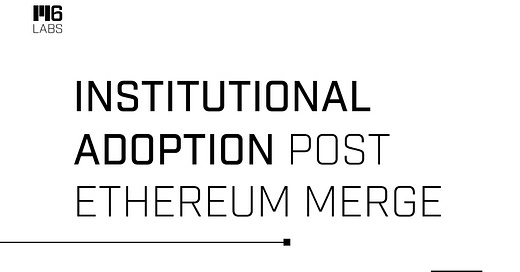Institutional Adoption Post Ethereum Merge
Let's break down what this will mean for institutional adoption specifically
A lot has been said about what the #Merge means for #Ethereum and #Web3 space in general. Let's break down what this will mean for institutional adoption specifically.
Before we get started... Want early access to our research threads? Sign up to our Substack to receive daily coverage on everything you need to know about going on in the crypto directly in your inbox:
Done? Now let's dive in!
We know the PoS shift has led to a 99% reduction in energy consumption (due to the removal of GPU). This benefits institutional investors since they must comply with ESG mandates. Investors will be able to maximize their yields without compromising sustainability.
Investors will be able to receive a positive real yield of up to 13.2%. This is an alluring prospect in a world of negative real yields. Furthermore, staking ETH using centralized platforms like Lido will allow retaining liquidity in the form of #ETH derivatives.
Reduced issuance and increased burns will make ETH one of the few assets that are deflationary in nature. This is a very attractive investment proposition given the growth of Web 3.
With lower barriers to participation in the network comes better decentralization. With improved decentralization comes an increase in network security. Currently, more than 13M ETH has been staked by over 418k validators. Given that, a 51% attack would cost over $11B.
There are fewer centralized points of failure as a result of collaboration across the protocol ecosystem. The community may build and carry out its plans with confidence. This greatly decreases risks for institutions, allowing more risk-averse portfolios to invest.
#Dapps and #L2 scaling solutions will leverage better security, allowing them to scale and grow at an improved pace. This might result in yet another burst of applications being deployed, and consequently, more opportunities for institutions.
The most fully interoperable live client instances are found on the Ethereum network. Any major coding language can be integrated, and this can be done in cooperation with various enterprises. The variety of choices will let institutions decide how they wish to use Web 3.
Crypto funds will probably add protocol staking for baseline returns to their investing mix. In addition to various farming approaches funds may use, liquid staking will offer liquid yield returns.
With high-volume trades and position adjustments post Merge, trading firms are expected to see short-term advantages. Market makers have lucrative opportunities during volatile markets.
For endowments and pension funds, existing 401K spot exposure to cryptocurrency assets may also include token derivatives of these assets. Positions may need to be changed for long-term profitability.
Traditional firms and financial institutions may look at ways to gain exposure to DeFi services as ETH significantly reduces its carbon footprint. This starts with NFT drops or the integration of wallet functionality for stablecoin conversion and custody into banking apps.
Subscribe to receive our daily brief, extended weekly newsletter, and in-house research content!
Please Share, Leave Feedback, and Follow Us on Twitter, Telegram, and LinkedIn to stay connected with us.





